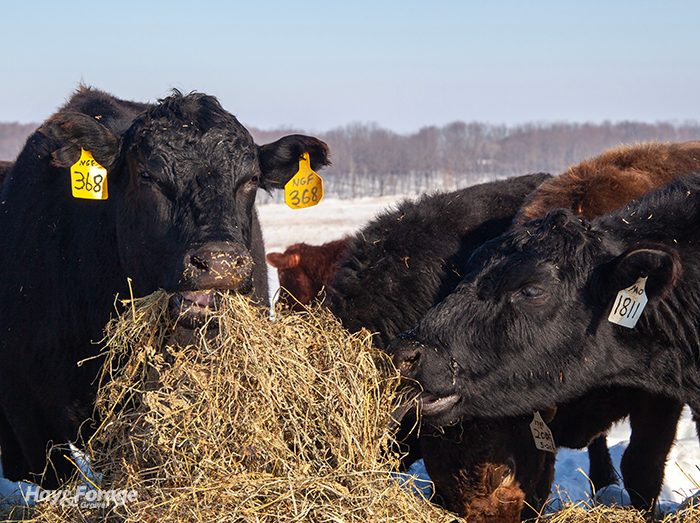
Bale grazing saves time and labor during the coldest months of the year. Moreover, putting bales out on a pasture in a grid pattern, and using temporary fence to strip graze cattle through the rows, facilitates a better distribution of nutrients from hay waste and manure. But there can be some bumps in the road to successful bale grazing.
In an episode of the University of Wisconsin’s “Field Notes” podcast, Jason Cavadini and Lynn Johnson discuss the advantages and disadvantages of bale grazing. The grazing outreach specialist with the University of Wisconsin-Madison Division of Extension and the grazing consultant for the Northwest Wisconsin Grazing Network, respectively, both implement the practice on their own farms and shared what they’ve learned after years of experience.
“Bale grazing is a solution for issues that come up when feeding hay to cattle,” Johnson said. “It’s a responsible way of managing nutrients on the farm.” He added that bale grazing reduces fuel costs and equipment use, not only from less bale handling, but also because farmers don’t have to collect manure in a feedlot and haul it to fields come spring.
Bale grazing also offers greater animal comfort. “Being able to be spread out and have a clean area to lie down — even using the bales that are positioned in the field as a windbreak — those are subtle advantages,” Johnson said. “I think the centerpiece, though, is nutrient management and protecting the soil and water quality in that area.”
Cavadini concurred. Although the reason he started bale grazing was due to a lack of infrastructure for winter hay feeding, he has continued to do it for the positive impact it has had on pasture fertility and the observed boost in forage production during the growing season.
Additionally, Johnson suggested that bale grazing requires farmers to take an inventory of their hay, which gives them more control over their winter feed budget. It also allows for an adjustable feeding schedule since farmers can make fence moves according to their schedules or in avoidance of adverse winter weather.
“When you’re bale grazing, you have some flexibility in when you choose to make the hay accessible to livestock — you can do that on nice days,” Johnson said. “If you do some planning ahead, you can create a more pleasant environment when you’re setting up the next bales to feed.”
Overcome these obstacles
With that said, bale grazing isn’t a plug-and-play practice — it will require some trial and error. Cavadini has tweaked his approach to bale grazing every year, admitting that when he started, he was spacing bales too far away.
“I used to burn up 20 acres from bale grazing in the winter, even with a smaller herd than I have now,” Cavadini shared. “Now, I use 2 to 3 acres with much tighter spacing, but I’m getting uniform coverage on that land.”
Cavadini also stated that bale grazing isn’t a silver bullet. One of the biggest disadvantages of the practice on his farm is the muddy transition from winter to spring. But being proactive can mitigate some of the mess.
“If you’re going to bale graze, you can’t start thinking about it at the end of September — you have to be thinking about it all year,” Cavadini said. “Look at your topography and where water can concentrate — that’s where you want to avoid ending up in April. And there are some places we want to avoid bale grazing altogether. We don’t want to concentrate nutrients in a place where water will accumulate or flow through.”
Johnson added that having access to a feedlot or cement pad offers a backup option if field conditions get too soft. In some cases, it may be necessary to pull cattle off the pasture to reduce pugging and compaction.
Severe winter weather can also wreak havoc on bales and create hay waste before cattle have a chance to graze them. “We have to anticipate that when we budget hay,” Cavadini said. “I usually plan for 10% to 15% waste — but it’s not necessarily waste because it goes back to the soil.” Water access is another critical factor that farmers must consider when drawing up their bale-grazing game plan.
That game plan should evolve with time and experience, though, and Johnson encourages farmers to make the practice their own. “In my observations, individuals that are bale grazing all have a different system that fits their farm, their personality, and their list of preferences,” he said. “It’s not a one-size-fits-all strategy — it’s a concept.”
